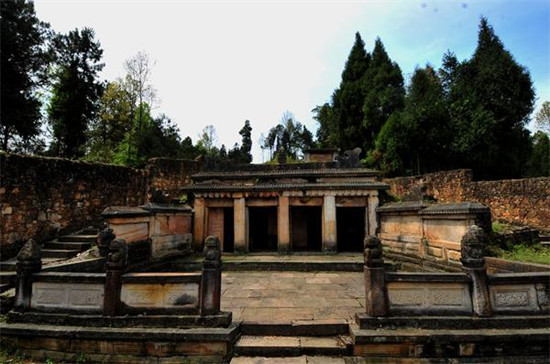Tangya Tusi site in Xianfeng County
- Source: Hubei Provincial People's Government
- 07/20/2015 10:29
- 0 749


the panorama of Tangya Tusi site


The Site of Tangya Tusi Domain, also known as the Tangya Tusi Ancient City Site, is located in Xianfeng County, Enshi Tujia and Miao Autonomous Prefecture, Hubei Province. It is the largest and best-preserved Tusi site in the ethnic minority regions in Hunan, Hubei, Sichuan, and Yunnan. It was listed as a national key historical and cultural site under state protection in 2006. In July, 2015, it was listed as an UNESCO world cultural heritage site, together with the Site of Laosicheng Tusi Domain and the Site of Hailongtun Tusi Fortress. It is the 48th China World Heritage Site.
History
The Tusi system was a hereditary political system adopted in ethnic minority regions by feudal rulers in ancient China. The supreme leader in the system is called Tusi, the chieftain. Chinese Tusi sites are mainly distributed in the mountainous area of the provincial boundaries of Hunan, Hubei and Yunnan. Currently, there are more than 100 Tusi sites in China, including the sites of domains and fortresses.
The Tangya Tusi system came into existence in the sixth year (1346) of the reign of Emperor Shundi in the Yuan Dynasty (1368-1644), and was abolished in the thirteenth year (1735) of the reign of Emperor Yongzheng in the Qing Dynasty (1644-1911). It lasted 389 years and 18 generations.
Structural Layout
The Site of Tangya Tusi Domain is sandwiched by the Tangya River and the Xuanwu Mountain. With a total area of 183 acres (74 hectares), it consisted of 3 streets, 18 alleys, and 36 courtyards in the past. There used to be government offices, shooting ranges, barracks, prisons, zoos, temples, and wells. At present, there exist a great number of historical sites, while the roads of the Ming Dynasty (1368-1644), the archway presented by the imperial government, the tomb of the Chieftain Tan Ding, and the exquisite human and horse statues are best-preserved. Tourists can not only enjoy the magnificence of the imperial city, but also gain a basic knowledge of the Tusi culture.
Stone Archway
The imperial court bestowed a stone archway upon the Chieftain Tan Ding in memory of his great military achievements in the third year (1623) of the reign of Emperor Xizong in the Ming Dynasty. Supported by four pillars, the archway has three openings. To the left side of the archway stands a stone lion which is solemn, spectacular, and well-preserved. The either side of the archway bears the inscriptions and is carved with relief sculptures, including the Chieftain Tan Ding on a Cruise, fishermen, woodmen, farmers, scholars, natural scenery, legendary figures, and so on.
Human and Horse Statues
Two human statues and two horse statues stand in front of the Stone Archway by the Tangya River. The horses were carved out of a whole stone. The left stone horse is embellished with a rein, a bridle, and a saddle, with a length of 9.2 feet (2.8 meters), a width of 2.3 feet (0.7 meter) and a height of 7.8 feet (2.38 meters). The man by the horse wears a suit of armor, holding an umbrella and a sword. The right stone horse measures 8.2 feet (2.5 meters) in length and 6.8 feet (2.08 meters) in height. The head of the man standing by the horse is gone, with a remaining height of 5.2 feet (1.6 meters). The distance between the two horses is 5.2 yards (4.8 meters). The names of the craftsmen and the dates on which they were finished were engraved on the reins. The horses are not very tall, but pretty strong.
Tombs of Chieftain Tan Ding and His Wife
The Tombs of Chieftain Tan Ding and His wife are located in the northeast of the domain, with a total area of 478 square yards (400 square meters). In front of the tomb is an octagonal sacrificial terrace, decorated by a kylin sculpture on either side. The tomb layout and the exquisite decorations represent the essence of the Tusi Culture and show tourists the level of stone carvings at that time. Additionally, the tumulus is well-preserved. The whole tomb looks very grand and splendid. To the left of Chieftain Tan Ding’s Tomb is the Tomb of his Wife, in front of which stand a stone tablet and a stone archway. The tablet is decorated with the patterns of tables and desks, measuring 3.2 feet (0.97 meter) in width and 6.2 feet (1.9 meters) in height. The stone archway is simply designed, with a height of 11.5 feet (3.5 meters).
Transportation
Take a long-distance bus to Xianfeng County at the Enshi Hangkonglu Passenger Station; upon arrival at the Xianfeng Passenger Station, change to a local public mini-bus to Tangya Township, and walk to the site. The long-distance bus is available from 7:00 to 17:30 for CNY 45 or 60. The frequency is 30 minutes, and the duration is about 80 minutes.